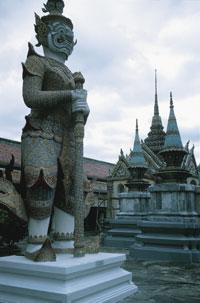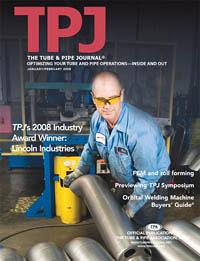- FMA
- The Fabricator
- FABTECH
- Canadian Metalworking
Categories
- Additive Manufacturing
- Aluminum Welding
- Arc Welding
- Assembly and Joining
- Automation and Robotics
- Bending and Forming
- Consumables
- Cutting and Weld Prep
- Electric Vehicles
- En Español
- Finishing
- Hydroforming
- Laser Cutting
- Laser Welding
- Machining
- Manufacturing Software
- Materials Handling
- Metals/Materials
- Oxyfuel Cutting
- Plasma Cutting
- Power Tools
- Punching and Other Holemaking
- Roll Forming
- Safety
- Sawing
- Shearing
- Shop Management
- Testing and Measuring
- Tube and Pipe Fabrication
- Tube and Pipe Production
- Waterjet Cutting
Industry Directory
Webcasts
Podcasts
FAB 40
Advertise
Subscribe
Account Login
Search
Tube Southeast Asia expo sheds light on Thailand, region
- By Eric Lundin
- January 15, 2008
- Article
- Shop Management
It's a vacationer's paradise—beaches in the south, mountains in the north, nightlife in the capital city, and low prices on nearly every consumer good under the sun. Like all emerging economies, it has a vibrant and growing manufacturing sector. It also happens to be centrally located in Southeast Asia, and draws people from all over: Malaysia, India, China, Japan, South Korea, and Singapore. These three factors came together when Bangkok hosted Tube Southeast Asia Oct. 16-18.
While many of the countries in the region have a few things in common—many are export-driven and peg their currencies to the U.S. dollar—in more ways they are different from each other. The population differences are extreme, from tiny Singapore (population 4.3 million) to colossal China (1.3 billion). Output per person, measured as gross domestic product (GDP) per capita, ranges from a low of $3 in India to $31,000 in Japan. The trade-to-GDP ratio, which is a measure of international trade compared with a nation's internal trade, is low in Japan (25.6) and a hard-to-believe 431.8 in Singapore.
In these measures, Thailand is somewhere in the middle of the pack, with a population of 64.2 million, GDP per capita of $8,600, and a trade-to-GDP ratio of 137.7.
Economic structures also vary from country to country. India's economy, which was run along socialist lines until the early 1990s, employs 60 percent of its labor force in agriculture and related industries; 28 percent in services; and 12 percent manufacturing. Singapore's economy, characterized by minimal government intervention, employs 39 percent in financial and business services, 18 percent in manufacturing, and has no agriculture industry. Here again, Thailand is between the extremes, with an agricultural segment that employs 49 percent of its population, a services industry that employs 37 percent, and an industrial sector that employs 14 percent.
Global Trends, Local Trends
It's no secret that the rising economic tide around the world over the past few years has brought newfound prosperity to many emerging economies, lifting many people from poverty into the middle class. An expanding middle class means increased consumer spending, and many businesses have been chasing higher profits by increasing direct investment in such countries.
Greater amounts of investment invariably lead to new equipment purchases, and visitors to Tube Southeast Asia were exposed to some of the latest manufacturing technologies, including automated tube benders with robotic unloading; tube expansion machines; and modern tube mills and roll tooling.
Still, despite having relatively open economies (the median trade-to-GDP ratio is approximately 110 in the region) and a hunger for new technologies, these markets have a handful of entry barriers.
"These can be very difficult markets to break into," said Walter Heller, vice president of tube mill sales for T&H Lemont Inc., a tube mill manufacturer. "First, competing with local manufacturers can be difficult," he said, citing competition from Thai Rolling Machinery Co. Ltd. (based in Bangkok) and SMACO, a tube mill manufacturer based in Malaysia. "Second, dollar value differences come into play," Heller said. The dollar is low now, so these days the situation is favorable in countries that don't peg their currency to the dollar, but that could change overnight. Last, while tube producers in the region are eager to increase their output through technology advancements, according to Heller, they aren't necessarily looking for big leaps in technology. "Cost is always an important factor," Heller said.
Despite the hurdles, Heller is hopeful about prospects in Asia. A driving concern is product quality, especially considering the quality reputation of tubular exports from China lately. Local producers are likewise interested in quality equipment, and this puts U.S. equipment manufacturers in a good position.
"'Made in the USA' implies quality," Heller said.
A Rising Tide of Oil
The world's burgeoning demand for energy has boosted the spirits and sales of nearly every company that makes drilling or refining equipment. Manufacturers that produce API-grade pipe have seen their fortunes change as the price of oil broke barrier after barrier over the past few years. After falling to less than $10 per barrel in 1998, oil broke through $30 per barrel in 2000, $40 per barrel in 2004, $50 per barrel in 2005, $60 per barrel in 2006, and $80 per barrel in 2007.
Ajax TOCCO, a manufacturer of quench-and-temper lines suited to API pipe, has observed that the interest in such equipment has mirrored the rising demand for oil.
"Demand for quench-and-temper lines has been strong for about five years now," said Terry Rose, the company's regional manager for Asia. "There is no foreseeable letup in demand," he said, adding that demand for the company's pipe-threading machines also has gone up sharply in recent years.
Still, the demand hasn't been consistent across the board. Rose mentioned that the growth in Asia has varied substantially. "We have had a slow year in at least one Asian country since 2003 or so."
The hot markets these days? Rose cited Malaysia and India as the sources of the most serious discussions for likely projects and potential equipment installations.
Need Some Tooling for That Mill?
D.B. Engineering Pvt. Ltd., a tooling manufacturer based in New Delhi, exhibited in Thailand for the first time at Tube Southeast Asia. Atul Beri, a sales engineer for the company, said that overall the use of tubing in Asia is on the rise.
"I am seeing quite a bit of interest from the construction industry," he said, citing pipeline production as the second-highest area of interest.
Like other manufacturers that rely on steel, tooling manufacturers are in a bind today. Rising demand for tooling is good news, but right now the supply of raw material is a problem.
"The delivery times for tool steel from Europe are too long," Beri said. The average delivery time is eight months, he added. Consequently, D.B. Engineering tries to stock as much as it can.
Regarding manufacturers in the region, Beri's observations mirror those of Heller—many are increasingly interested in new technologies. For Beri, this means advanced types of tool steel and carbide tooling. Many are interested in tooling that lasts longer, despite a higher cost, but this guideline isn't for everyone.
"Regional economic factors play into it," Beri said. He made the same observation that Heller did—many manufacturers are interested in technology advancements, but cost is always an issue. For instance, in many European countries, the number of working hours has decreased in recent years, so manufacturers in those countries are willing to pay four or five times more for tooling that lasts longer than less expensive tooling. Longer-lasting tooling doesn't have to be changed as frequently, and this is a huge advantage in a country with a shrinking number of working hours.
"It depends on other factors, too, such as interest rates and labor rates," he said.
It also depends on the applications, and some of Beri's inquiries are proof that unusual manufacturing applications are popping up in Thailand.
"I got one inquiry for tooling for making aluminum-coated steel tubes, and I have had discussions about manufacturing tube for hydroforming and flow-forming," he said.
Plastic Pipe for Black Gold and Clean Water?
While the global economic boom has been a boon to steel pipe producers and their suppliers, everyone in this industry should be aware that plastic pipe is gaining ground in energy and water applications.
Pipelife Nederland B.V. and Teijin Twaron® B.V. teamed up to produce SoluForce®, a high-pressure plastic pipe intended for gas distribution, hydrocarbon production, and water service. Available in 4-inch and 5-in. IDs, the pipe consists of a polyethylene core, a layer of Twaron (a synthetic material similar to Kevlar®), and an outside layer of UV-resistant polyethylene.
Users roll out a length of the pipe (up to 1,312 ft. [400 m] long) and use a specially designed CNC machine to trim and join one pipe to the next. The joining process doesn't require human intervention; joining two pipes takes about 45 minutes; attaching an end fitting takes about 25 minutes. The company claims the installation rate is approximately 0.6 mile (1 km) per hour.
A plastic coupling is used to join one length of plastic pipe to another or a metal end fitting to join it to a steel pipe.
Although this particular pipe is more expensive per foot than a similar length of steel pipe, it is less expensive to transport and install, according to Theo Arnts, technical regional manager for the company's Asia and Pacific regions. And, because it is plastic, it doesn't require an inspection and it doesn't corrode. Further, it can be laid directly on the ground. There is no need to lay it on blocks or any other type of support to keep it off the ground.
"This pipe costs more per foot than steel pipe," said Arnts, "but an installation costs less because joining the pipe goes quickly and inspection is not necessary."
What's in Store for Thailand?
While the markets are hard to crack open and competition is heavy, Thailand has plenty of potential. Industrial growth in Thailand is moving at a stunning clip. In opening Tube Southeast Asia, Chakramon Phasukavanich, Thailand's permanent secretary for the Ministry of Industry, said that energy demand has increased an average of 40 percent per year for the last 15 years. Phasukavanich added that the country's three natural gas pipelines run 1,615 miles (2,600 km), and the country will commission a fourth pipeline in 2010.
Meanwhile, data from Thailand's Board of Investment reveals that, after letting investment in Thailand grow rapidly from 2003 to 2004 ($8.35 billion to $17.67 billion, or more than 110 percent in one year), the board cut investment to $10.98 billion in 2006. It has since unleashed investment and approved $15.78 billion in projects between January and September 2007.
Among the industries targeted for growth by the Thai government, three rely on machines or goods manufactured by tube and pipe producers and fabricators—agriculture, alternative energy, and automotive.
About the Author

Eric Lundin
2135 Point Blvd
Elgin, IL 60123
815-227-8262
Eric Lundin worked on The Tube & Pipe Journal from 2000 to 2022.
About the Publication
subscribe now

The Tube and Pipe Journal became the first magazine dedicated to serving the metal tube and pipe industry in 1990. Today, it remains the only North American publication devoted to this industry, and it has become the most trusted source of information for tube and pipe professionals.
start your free subscription- Stay connected from anywhere

Easily access valuable industry resources now with full access to the digital edition of The Fabricator.

Easily access valuable industry resources now with full access to the digital edition of The Welder.

Easily access valuable industry resources now with full access to the digital edition of The Tube and Pipe Journal.
- Podcasting
- Podcast:
- The Fabricator Podcast
- Published:
- 04/16/2024
- Running Time:
- 63:29
In this episode of The Fabricator Podcast, Caleb Chamberlain, co-founder and CEO of OSH Cut, discusses his company’s...
- Trending Articles
Zekelman Industries to invest $120 million in Arkansas expansion

3D laser tube cutting system available in 3, 4, or 5 kW

Corrosion-inhibiting coating can be peeled off after use

Brushless copper tubing cutter adjusts to ODs up to 2-1/8 in.

HGG Profiling Equipment names area sales manager

- Industry Events
16th Annual Safety Conference
- April 30 - May 1, 2024
- Elgin,
Pipe and Tube Conference
- May 21 - 22, 2024
- Omaha, NE
World-Class Roll Forming Workshop
- June 5 - 6, 2024
- Louisville, KY
Advanced Laser Application Workshop
- June 25 - 27, 2024
- Novi, MI





























